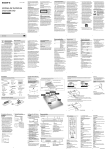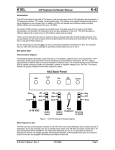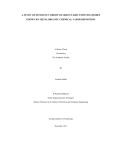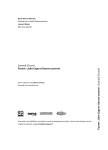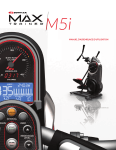Download DMARS/GARS User`s Manual
Transcript
DMARS/GARS User’s Manual 1.0 GENERAL INFORMATION 1.1 Unpacking/Handling: DMARS/GARS is a very delicate instrument. It contains gyroscopes and accelerometers which are mechanically and electrically sensitive. Please exercise extreme caution when handling the system. Electrostatic: DMARS/GARS is an electrostatic sensitive device. A standard anti-static procedure has to be exercised. Please do not remove the anti-static cap from the connector whenever DMARS/GARS is not in use. Mechanical Shock: DMARS/GARS is sensitive to mechanical shock and vibration. It's calibration constants may be changed as a result of any possible damage. The Crash Safety shock is 15g 11ms one time per direction. 1.2 Mounting: Fastener: DMARS/GARS is provided with four (4) 0.200 inch mounting holes on a 4.800 inch diameter. These holes are for UNC 10-24 hexnut screws with washers. The recommended screw mounting torque is 30 ounce-inch. Orientation: DMARS/GARS is an omni-directional system which compensates its mounting matrix to orient its desired direction, however, its default orientation is labeled on the DMARS/GARS. The roll axis should be parallel to that of the vehicle, meanwhile, the yaw axis should be facing down. Since the DMARS/GARS's thermal characteristics have been calibrated with it's yaw in the down position, a better performance is expected in this position compared to being in the upside down position. Any mounting misalignment angles and positions should be measured and compensated by using the IS_PC_CDU program. Please refer to the IS_PC_CDU software. To ensure the mounting repeatability, please use a 2 dowel pin arrangement against a reference surface indicated in the attachment #1 drawing. Mounting Surface: A flat mounting surface with a flatness of 0.001/inch and a roughness better than 65rms is preferred. Please notice that there is a 0.015 mounting clearance indentation under the mounting surface. (Please refer to attachment #1). Inertial Science, Inc. 3533 Old Conejo Road, Suite #104 Newbury, Park, CA 91320 Telephone: (805) 499-3191, Fax: (805) 498-4882 http://www.inertialscience.com, email: info@inertialscience.com Copyright © 2003, Inertial Science, Inc., All Rights Reserved. Heat Sink Consideration: DMARS/GARS generates 17 Watts of power. A 12"x12"x1/2" aluminum mounting plate or a larger thermal mass is sufficient to dissipate the heat. An add-on heat sink is available as an option, upon request. GPS Antenna mount: A pair of magnetic fasteners and two 4-40 tap holes are also available under the antenna. Please mount the antenna where a maximum satellite visibility, solid angle, is available. 1.3 Connector: A 26 pin high density D-type female connector, CONEC Corp. 241A16510 or equivalent, is mating connector. Wiring: The following pins should be wired and connected before use. pin 1 (awg 26 or larger) to +28v power input pin 2 (awq 26 or larger) to +28v power input pin 3 (awg 26 or larger) to power return pin 4 (awg 26 or larger) to power return (AWG 22 preferred) (AWG 22 preferred) (AWG 22 preferred) (AWG 22 preferred) note: Power in reverse polarity is protected. pin 19 (shielded twisted pair line 1) to pin 2 of PC com connector pin 20 (shielded twisted pair line 2) to pin 3 of PC com connector pin 21 (shielded twisted pair shield) to pin 5 of PC com connector pin 26 (awg 26 or larger) to chassis ground or to power return other pins are factory use or disabled. Please leave them open. Cable Clamping: A cable clamp is provided for both the main connector and the antenna wires. 1.4 Power-on sequence: The GPS antenna is not necessary for the power on sequence, but we recommend that it be connected to the DMARS/GARS, before power-on. Power On: 0 to 20 seconds: Performs initialization and BITE 20th second: Communication starts. IS_PC_CDU starts to show data. Inertial Science, Inc. 3533 Old Conejo Road, Suite #104 Newbury, Park, CA 91320 Telephone: (805) 499-3191, Fax: (805) 498-4882 http://www.inertialscience.com, email: info@inertialscience.com Copyright © 2003, Inertial Science, Inc., All Rights Reserved. 20 to 45 seconds: Gyros go into initialization. It is normal to hear a chirping noise during the spin-up period, or during a cold start. 45th second: DMARS/GARS is in zero velocity damping mode, and is in Coarse heading (yaw)_align mode. This coarse align function will be replaced by heading input ($INhdgxxx.xxx), or by an available GPS heading. 100 to 400 seconds: GPS fixes its position. Position fixing time varies depending on the conditions. The DMARS/GARS contains a back-up battery to power the GPS’s quick acquisition function. This back-up battery should last more than 3 years. Reacquisition should take: Cold start <160 sec Warm start <45 sec Hot start <20 sec 45 sec after power on After the GPS fix: DMARS/GARS zero velocity damping mode is terminated and replaced by a GPS aided mode. When the GPS OK sign is on, the DMARS/GARS is ready for navigation. As long as the GPS signal is valid, DMARS/GARS navigates using the GPS aided mode, and a short term interruption of the GPS signal will not effect the navigation quality. If a GPS signal is not healthy for a longer period, the DMARS/GARS has other navigational modes. Please refer to IS_PC_CDU section for further details. 1.5 Calibration DMARS/GARS may not require any periodic calibration. By the read-out, some parameters in the DMARS/GARS E2 prom may indicate the health of the system. Please contact the factory for further details. 1.6 Warranty and Repair ISI warrants to Buyer that at the time of shipment the products will be free from defects of material and workmanship and will conform to the applicable ISI drawings and specifications. Should any such defect become apparent within 12 months from delivery thereof to Buyer, ISI’s sole obligation under this warranty will be limited to either, at Inertial Science, Inc. 3533 Old Conejo Road, Suite #104 Newbury, Park, CA 91320 Telephone: (805) 499-3191, Fax: (805) 498-4882 http://www.inertialscience.com, email: info@inertialscience.com Copyright © 2003, Inertial Science, Inc., All Rights Reserved. ISI’s option and expense, repairing, replacing or extending credit for the products or parts thereof returned to ISI by Buyer, F.O.B. ISI’s plant, and which ISI reasonably determines do not conform to the warranty and Buyer’s exclusive remedy for breach of such warranty will be enforcement of such obligation. The foregoing warranty is exclusive and in lieu of all other warranties, whether express, implied or statutory, including, but not by way of limitation, any warranty of merchantability of fitness for any particular purpose. Inertial Science, Inc. 3533 Old Conejo Road, Suite #104 Newbury, Park, CA 91320 Telephone: (805) 499-3191, Fax: (805) 498-4882 http://www.inertialscience.com, email: info@inertialscience.com Copyright © 2003, Inertial Science, Inc., All Rights Reserved. 2.0 DMARS/GARS I/O Pin 19 transmits 26 bytes of RS232 data, 115.2 Kbaud, no parity, 8 bit, 1 stop bit data. Pin 20 receives RS232 data, 115.2 Kbaud, no parity, 8 bit, 1 stop bit data. Pin 21 is common. 2.1 TX Message Format: Middle 12 bytes (byte #5_16) are 2S’C decoded data, meanwhile, byte #17 through 23 are either single or double precision floating point data format. Output has 100 frames per second and has 26 bytes data stream consisting of: Byte # 1 2 3 Signal Description Preamble Address Up count 4 5 6 7 8 9 10 11 12 13 14 15 16 17 18 19 20 21 22 23 24 25 26 Status Roll Angle H Roll Angle L Pitch Angle H Pitch Angle L Yaw Angle H Yaw Angle L Roll Rate H Roll Rate L Pitch Rate H Pitch Rate L Yaw Rate H Yaw Rate L Slow Data Field MSB 7 Slow Data Field 6 Slow Data Field 5 Slow Data Field 4 Slow Data Field 3 Slow Data Field 2 Slow Data Field 1 Slow Data Field LSB 0 SDID, Slow Data ID CS Scale Factor Fixed number Fixed number Increment by 1 per frame Range 7EH FFH 0 to 99 Synch with GPS 1PPS See note 1 215 = 180.0 deg ± 90 deg 215 = 180.0 deg ± 180 deg 215 = 180.0 deg ± 180 deg 215 = 100.0 deg/sec ± 100 deg/sec 215 = 100.0 deg/sec ± 100 deg/sec 215 = 100.0 deg/sec ± 100 deg/sec Double Precision Data Field Exclusive or byte 1 to 25 00_FF Note 1: Status MSB bit 7 1 = BITE OK bit 6 1 = Gyro Enables bit 5 1 = temp not too high bit 4 1 = temp not too low bit 3 1 = GPS ready Inertial Science, Inc. 3533 Old Conejo Road, Suite #104 Newbury, Park, CA 91320 Telephone: (805) 499-3191, Fax: (805) 498-4882 http://www.inertialscience.com, email: info@inertialscience.com Copyright © 2003, Inertial Science, Inc., All Rights Reserved. LSB bit 2 1 = Navigation ready bit 1 1 = TBD bit 1 1 = TBD To decode roll angle: roll_angle = b(5) * 256 + b(6). If roll_angle > 32767, then roll_angle = roll_angle – 65536. Slow Data 10 data/sec Up Count # 0,10, 20…90 1, 11, 21…91 2, 12, 22…92 3, 13, 23…93 4, 14, 24…94 5, 15, 25…95 6, 16, 26…96 Byte #17, 18, 19, 20 Latitude (deg) Longitude (deg) Altitude (m) Vel_East (m/sec) A_North (∆V m/sec/0.1 sec) A_Up (∆V m/sec/0.1 sec) Body Accel – Pitch (∆V m/sec/0.1 sec) Slow Data 1 data/sec (Default) Up Count # Byte #17, 18, 19, 20 7 LAR (m) 8 LAY (m) 9 DAP (m) 17 MAR (m) 18 MAY (m) 19 27 a_g1 (deg/sec) 28 a_g3 (deg/sec) 29 a_a2 (m/sec2) 37 Evt_time (sec) 38 Temp_g1 (deg. C) 39 Temp_a (deg. C) 47 Lat_GPS (deg) 48 Alt_GPS (m) 49 Vel_East_GPS (m/sec) 57 Vel_H_Avg (m/sec) 58 Yaw_GPS (deg) Byte #21, 22, 23, 24 (Double precision) (Double precision) Vel_North (m/sec) Vel_Up (m/sec) A_East (∆V m/sec/0.1 sec) Body Accel_Roll (∆V m/sec/0.1 sec) Body Accel – Pitch (∆V m/sec/0.1 secr Byte #21, 22, 23, 24 LAP (m) DAR (m) DAY (m) MAP (m) a_g2 (deg/sec) a_a1 (m/sec2) a_a3 (m/sec2) GPS_time (sec) Temp g2 (deg. C) Temp_at (deg. C) Lon_GPS (deg) Vel_North_GPS (m/sec) Vel_Up_GPS (m/sec) Vel_Up_Avg (m/sec) Inertial Science, Inc. 3533 Old Conejo Road, Suite #104 Newbury, Park, CA 91320 Telephone: (805) 499-3191, Fax: (805) 498-4882 http://www.inertialscience.com, email: info@inertialscience.com Copyright © 2003, Inertial Science, Inc., All Rights Reserved. 59 67 68 69 77 78 79 87 88 89 97 98 KGPS Align_flag GPS_1Hz_cnt Nav_flag GPS_flag GPS_OK_cnt BITE X address Data 2 Data 4 Temp_sta Data 1 Data 3 Data 5 Date code Custom ID (character Unit SN (character string) string) 99 Rx_c_msg1 (character Rx_c_msg2 (character string) string) Note: All data are single precision unless otherwise specified. To decode single precision: 1st single precision b(17) to b(20) ex = 2 * ((127 and b(20) + (128 and b(19))/128-126 ma = 0.5 + ((127 and b(19)) + (b(18) + b(17)/256)/256)/256) s1 = ma * 2ex 2nd single precision b(21) to b(24) ex=2 * (127 and b(20)) + (128 and b(19))/128-126 ma = 0.5 + ((127 and b(23)) + (b(22) + b(21)/256)/256)/256) s2 = ma * 2ex To decode double precision b(17) thru b(24): ex=16 * (127 and b(24)) + (240 and b(23))/16-1022 ma = 0.5 + ((15 and b(23)) + (b(22) + (b(21)+(b(20) + (b(19) + (b(18) + b(17))/256)/256)/256)/256)/256)/32 lon = ma * 2ex Inertial Science, Inc. 3533 Old Conejo Road, Suite #104 Newbury, Park, CA 91320 Telephone: (805) 499-3191, Fax: (805) 498-4882 http://www.inertialscience.com, email: info@inertialscience.com Copyright © 2003, Inertial Science, Inc., All Rights Reserved. 2.2 RX Message Format: RX Message is an ASCII code somewhat similar to NMEA 0183 format for RS232 RX input. $INXXXD1,D2,D3 *[CR][LF] “$” The “$” signifies the start of a message IN The talker identification is a two letter mnemonics which describes the source of the navigation information. The IN identification signified inertial systems. XXX The message identification is a three letter mnemonic which describes the message content and the number and order of the data field. “,” Comas serve as delimiters for the data fields. Dn Each message contains multiple data fields (Dn) which are delimited by commas. “*” The asterisk serves as a checksum delimiter. CS It is a two ASCII characters which indicates the hexadecimal value of an exclusive “or” from “$” to “*” checksum. This number is optional and DMARS ignores it. [CR][LF] The carriage return [CR] and line feed [LF] combination terminate the message. Commands: $INrss* This command activates a software reset function. The DMARS will start from elapse time “0”, and it will restart the GPS. $INrsc* This command reloads E2 prom constants from a factory calibrated constants set. This command is only recommended only when the output data are spoiled by erroneously changed E2 prom data. $INaln*Coarse align yaw angle or heading. This command finds an INS calculated coarse heading with respect to the true north. This command is terminated by: 1. Another $INaln 2. When GPS heading measurements are valid. This command function is terminated by $INale. $INfnv *Free navigation command. This command forces DMARS into autonomous navigation mode. $INfne will terminate this command. $INbup* Inertial Science, Inc. 3533 Old Conejo Road, Suite #104 Newbury, Park, CA 91320 Telephone: (805) 499-3191, Fax: (805) 498-4882 http://www.inertialscience.com, email: info@inertialscience.com Copyright © 2003, Inertial Science, Inc., All Rights Reserved. This command is useful to estimate and correct the gyro’s and accel’s bias when the accurate position and the attitude of DMARS are known. This should not be used in the field. $INbue will terminate this function. $INtbl* This command loads E2 prom data into DMARS from a data set stored in the CDU computer data file. This command is useful during a field test where a certain parameters need to be changed. Changing positions $INposxxxx.xx,yyyy.yy,zzzz.zz* where xxxx.xx is latitude in degrees, north hemisphere has positive number. yyyy.yy is longitude in degrees, Eastern hemisphere has a positive number. zzzz.zz is the altitude in meters. WGS 84 referenced above mean sea level is positive. Caution $INpos*, $INpos,,* or $Inpos* command will input zero values to latitude, longitude and altitude. $INpos,111.0, * will input Latitude = 0.0 Longitude = 111.0 Altitude = 0.0 Individual position change commands: $INlat34.1933285* will change latitude to 34.1933285 deg $INlat* will change latitude to 0.0 $INlat34* will change latitude to 34.000 $INlon–118.95054* $INalt200.01* will change altitude to 200.01 m. Inertial Science, Inc. 3533 Old Conejo Road, Suite #104 Newbury, Park, CA 91320 Telephone: (805) 499-3191, Fax: (805) 498-4882 http://www.inertialscience.com, email: info@inertialscience.com Copyright © 2003, Inertial Science, Inc., All Rights Reserved. Changing Attitude $INatt1.023,-2.11,10.25 will change roll angle = 1.023 deg pitch angle = -2.11 deg yaw angle = 10.25 deg An unspecified number will change the corresponding value to 0.0. This command will terminate coarse align process. $INr111.023* will change roll angle to 1.023 deg. $INpch–2.11* Will change the pitch angle to –2.11 deg $INhdg10.25* will change heading angle to 10.25 deg. This command will terminate coarse align process. Changing GPS antenna lever arm length $INlam0.53,-1.3,-0.8* will change the measurement from the vehicle’s center of motion (CM) to the position of the GPS antenna in meter. First number is measured along the roll axis. This value should be positive if the antenna is located forward direction of the vehicle from CM. The second number is measure along the pitch axis. This value should be positive if the antenna is located in the right hand side of CM. The third number is measured along the yaw axis of the vehicle. This number should be positive if the antenna is located below CM. Individual values may be changed by $INlarxxxx.xxx* $INlapyyyy.yyy* $INlayzzzzz.zzz* Changing mounting misalignment angles $maaxxx.xxx,yyy.yyy,zzz.zzz* will change DMARS mounting misalignment angles. Along roll axis = xxx.xxx degree Inertial Science, Inc. 3533 Old Conejo Road, Suite #104 Newbury, Park, CA 91320 Telephone: (805) 499-3191, Fax: (805) 498-4882 http://www.inertialscience.com, email: info@inertialscience.com Copyright © 2003, Inertial Science, Inc., All Rights Reserved. Along pitch axis = yyy.yyy degree Along yaw axis = zzz.zzz degree An angle measurement of CCW from vehicle to DMARS along the axis should be a positive number. For example, if DMARS is mounted 10 degrees to the right hand side off from the vehicle’s roll_axis, the zzz.zzz number should be 10, 10.0 or 10.00. Individual values may be changed by: $INmarxxx.xxx* $INmapyyy.yyy* $INmayzzz.zzz* Note: These changes of the mounting misalignment angles are activated either by power on, reset, or by the $INRSS command. Changing position from CM to DMARS $INdlmxxx.xxx,yyy.yyyy,zzz.zzz* will change DMARS mounting position numbers measured from CM to DMARS along roll axis = xxx.xxx meter along pitch axis = yyy.yyy meter along yaw axis = zzz.zzz meter The xxx.xxx number should be positive if DMARS is mounted forward from CM. The zzz.zzz number should be positive if DMARS is mounted below CM level. There are no individual values change commands are available. $INlut* This command generates a new set of temperature calibration data. Factory use only. $INlue* Terminate $INlut command $INspdxxx.xxx* This command is provided to send a reference speed along the roll axis of the vehicle, such as and odometer speed. DMARS utilizes the speed to damp the navigation loop if there are no other aids available. This mode is a classic velocity damped navigation. DMARS expects 1 speed per ever second. $INspe* This command terminates $INspd command. Inertial Science, Inc. 3533 Old Conejo Road, Suite #104 Newbury, Park, CA 91320 Telephone: (805) 499-3191, Fax: (805) 498-4882 http://www.inertialscience.com, email: info@inertialscience.com Copyright © 2003, Inertial Science, Inc., All Rights Reserved. $INsvz* This command sets all velocity zero. $Insve* This command terminates $INsvz. Inertial Science, Inc. 3533 Old Conejo Road, Suite #104 Newbury, Park, CA 91320 Telephone: (805) 499-3191, Fax: (805) 498-4882 http://www.inertialscience.com, email: info@inertialscience.com Copyright © 2003, Inertial Science, Inc., All Rights Reserved. 2.3 Secondary TX Out RS 422, synchronous output with clock and RT1 This link is data transmission from DMARS only. This has no receiving capability. Protocol: SDLC, 921.6 Kbaud, zero insertion. TXD (TX data +; pin 9, TX data -; pin 8). Total Number of bytes is 30 Start Flag 16 Bit Address 7E AA55 Data Field 24 Bytes of Data* 16 Bit CRC CCITT, Preset 1 Byte 30 End Flag 7E *Note: 24 bytes of data are a duplication of RS232 data bytes 3 thru 26, including CS (please refer to section 2.1). TXC (TX clock +; pin 6, TX clock -; pin 7). 921.6 KHz synch clock. RT1 (Time of validity +; pin 25 time of validity -; pin 24). The rising edge indicates the sensor data latch. The falling edge indicates the TX data buffer filled. Inertial Science, Inc. 3533 Old Conejo Road, Suite #104 Newbury, Park, CA 91320 Telephone: (805) 499-3191, Fax: (805) 498-4882 http://www.inertialscience.com, email: info@inertialscience.com Copyright © 2003, Inertial Science, Inc., All Rights Reserved. 2.4 DMARS/GARS Connector Pin Assignment Connector Type Pin # 1 2 3 4 5 6 7 8 9 10 11 12 13 14 15 16 17 18 19 20 21 22 23 2 25 26 description +28V +28V 28V RTN 28V RTN Shield GND TxC (+) TxC (-) TxD (-) TxD (+) GND GND MOD_SW Vpp Vpps TxS5 RxS5 COM TxMON RxMON COM RTI (-) RTI (+) GND (26 pin high density D-type male connector) remarks power input1 power input1 power return1 power return1 RS-422 synchronous clock RS-422 synchronous clock RS-422 transmitting data RS-422 transmitting data ground ground Boot-up memory bank selection switch (Factory use only) Do not use +12V EEPROM programming power input (Factory use only) +12V EEPROM programming power supply (Factory use only) RS-232 Gatar Tx (Factory use only) RS-232 Gatar Rx (Factory use only) RS-232 Gatar common (Factory use only) RS-232 Tx RS-232 Rx RS-232 common Do not use Do not use RS-422, Time of Validity Signal RS-422, Time of Validity Signal Shield and Case ground Note 1. AWG 26 Gauge or thicker wires are recommended. Inertial Science, Inc. 3533 Old Conejo Road, Suite #104 Newbury, Park, CA 91320 Telephone: (805) 499-3191, Fax: (805) 498-4882 http://www.inertialscience.com, email: info@inertialscience.com Copyright © 2003, Inertial Science, Inc., All Rights Reserved. 3.0 IS_PC_CDU Program The DMARS/GARS package contains a CD with a display software named IS_PC_CDU. After you perform a set-up and run IS_PC_CDU will bring up a window screen for DMARS/GARS display and control. After the DMARS/GARS is powered on, and the RS232 connector is connected to one of the PC’s “COM”_port, the program is ready to run by clicking the “COM” button on the left top corner. A right click on this button allows a change to the “COM”_port number. Input selection of “LOGBIN” button will change the input source to the data file “LOGBIN.DAT”, instead of DMARS/GARS. IS_PC_CDU has two logging functions, “LOGBIN” and “LOGASC”. The “LOGBIN” command button will store all received data from DMARS/GARS to “LOGBIN.DAT”, a binary format file in the current directory. “LOGASC” command will store a set of selected decoded data in ASCII format as “LOGASC.DAT’ file in the current directory. The default format for “LOGASC” is: time, roll_rate, pitch_rate, yaw_rate, roll, pitch, yaw, lat, lon, alt. IS_PC_CDU displays slow_data field in a text box with a scroll_down bar. Quick scroll commands are located above the text box. T/X command combo box contains $IN command function. A dropdown list will show the command list. A selection of the command follows further instructions. Please refer to section 2.2 for command list details. Clicking the help button will show this document. Inertial Science, Inc. 3533 Old Conejo Road, Suite #104 Newbury, Park, CA 91320 Telephone: (805) 499-3191, Fax: (805) 498-4882 http://www.inertialscience.com, email: info@inertialscience.com Copyright © 2003, Inertial Science, Inc., All Rights Reserved. Inertial Science, Inc. 3533 Old Conejo Road, Suite #104 Newbury, Park, CA 91320 Telephone: (805) 499-3191, Fax: (805) 498-4882 http://www.inertialscience.com, email: info@inertialscience.com Copyright © 2003, Inertial Science, Inc., All Rights Reserved.


















